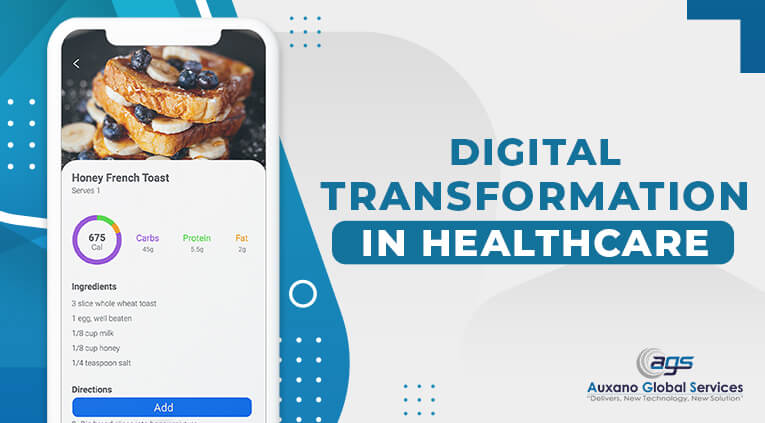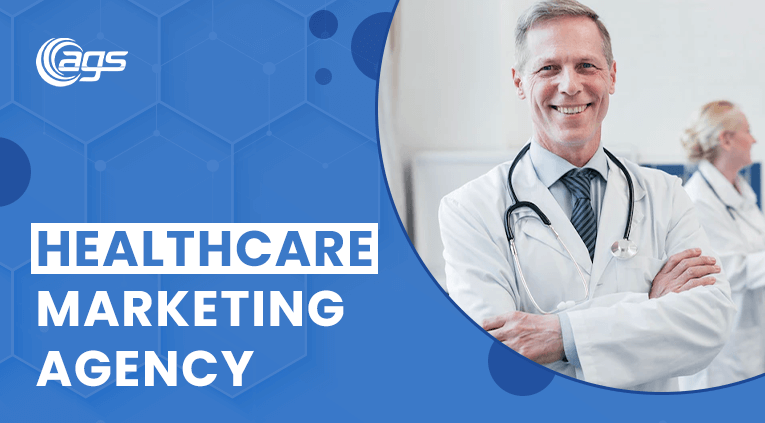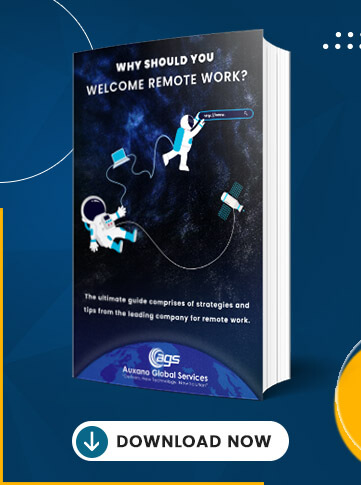Technology has been positively changing the healthcare industry.
Global Healthcare Cloud Computing Market to Reach $76.8 Billion by 2026.
The adoption of cloud computing, mobility, and big data has improved the way we work within this industry. This article will share a complete guide on SaaS for Healthcare Industry, what benefits the conventional IT model offers and why it should be replaced with software as a service (SaaS), how to analyze any SaaS-based solution, cost analysis of shift to the SaaS model, etc.
In order to overcome the problems faced by the healthcare industry today like rising COST OF CARE, quality of care issues the world over, inefficient hospital management, and lack of coordination among multiple health providers; there is a need for change from the IT model in conventional form i.e.
There is a lot of confusion about the term “SaaS” and its meaning. The acronym stands for Software as a Service and refers to applications that are provided by companies with no software installation requirements. With SaaS, you pay a monthly fee for use of the application – oftentimes an annual fee- to use it on any device.
Most companies offer “solutions” which include the ability to connect and communicate with customers, vendors, or partners via phone or email- all without sending staff out on site. These solutions have become very popular in the healthcare industry.
The SaaS solution takes the place of hiring someone full-time to work the phones and manage the communications. Not only are you saving money on staffing and space, but you are also getting more done in less time. The SaaS solution can also provide CSC (Claim Status Checking), a private label website, and other applications that are vital to any healthcare agency.
In this blog we will explain to you about:
1. What are the advantages of using SaaS in the healthcare industry?
2. HIPAA Compliance Checklist
3. What are the next Healthcare SaaS trends?
4. How do you create a healthcare SaaS application?
5. What will be the process of healthcare SaaS application development?
What are the advantages of using SaaS in the healthcare industry?
In the healthcare industry, the incident management process is central to providing quality care.
The HIPAA compliance issue led to the demand for electronic health records for medical data sharing and information management. SaaS has brought with it the ability to handle a lot of patient data efficiently.
The SaaS solution forms an integrated approach toward managing patient data—allowing the physician and healthcare provider to access patient data anytime and anywhere so that they are always up-to-date on the situation at hand while having access to all relevant information available.
SaaS for healthcare-based applications can be deployed at a fraction of the cost of traditional software. SaaS is flexible and can be easily modified on an as-needed basis. The SaaS application also reduces risks related to data loss and corruption, resulting in greater data security.
Let’s discuss the benefits of SaaS in the Healthcare Industry.
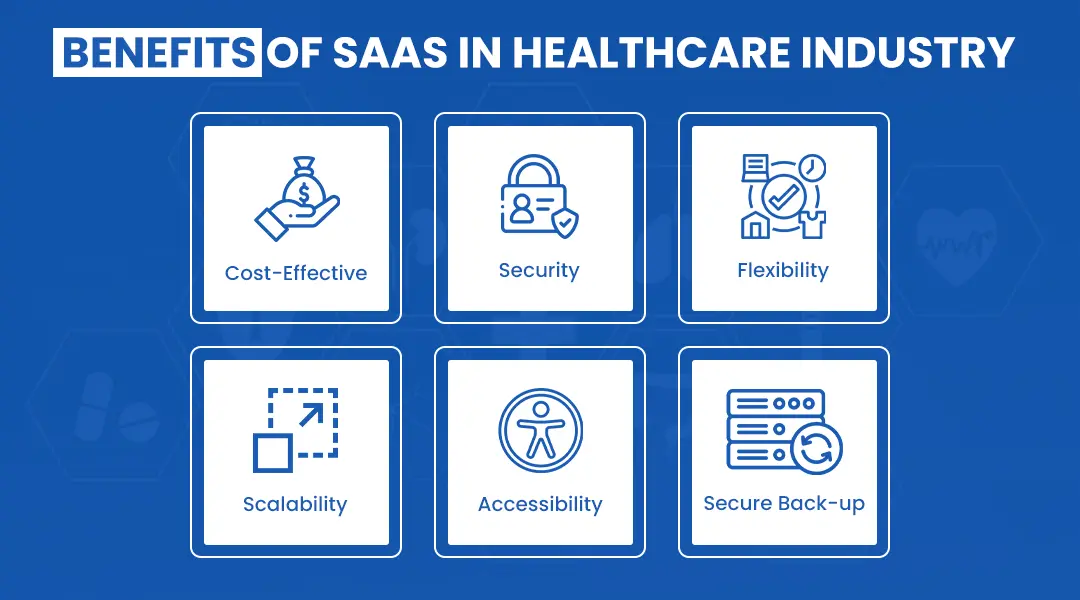
1. Cost-Effective
SaaS is cost-effective because you need not deal with the maintenance and installation of software. SaaS can also be easily modified, which makes it a good fit for the healthcare industry where data is valuable and an unexpected event or incident can wipe out months of work.
2. Security
In the healthcare industry, information is valuable and if an organization has sensitive data in SaaS, it will suffer from loss or theft of data. SaaS reduces the risk associated with your confidential medical records by syncing all medical information in one place. Hybrid cloud computing systems allow you to exchange personal health data between on-premises private cloud and Amazon Web Services (AWS).
3. Flexibility
In the healthcare industry, the goal is to deliver quality care that meets the needs of each patient. SaaS offers flexibility in configuring applications for different population sizes and geographies.
4. Scalability
The Healthcare industry is sensitive to changes and trends. There are also significant fluctuations in patient intake and output every day. SaaS eases this pressure as it offers greater scalability, which means that you can add more users or devices as the need arises.
5. Accessibility
SaaS is available on multiple platforms and devices. This helps healthcare professionals to access patient data from any location, which in turn ensures that the patient receives quality care at all times.
6. Secure Back-up
With SaaS, your data is secure and you are assured of its availability. This is because the provider guarantees access to complete applications and data if there is a failure of the primary site.
Checklist for HIPAA Compliance
Health Information Portability and Accountability Act (HIPAA) compliance regulations are among the most important concerns as far as the healthcare industry is concerned. A healthcare agency can function smoothly only after satisfying the HIPAA checklists or guidelines in a proper manner.
HIPAA compliance is a major hurdle that needs to be addressed to run any business related to the healthcare industry. Developing a solution devoid of all risk factors under the compliance mode could only be accomplished by using software that has been tested and verified for safety, reliability, and performance.
Here, we have listed and explained four points you must keep in mind while ensuring HIPAA compliance for your SaaS platform:
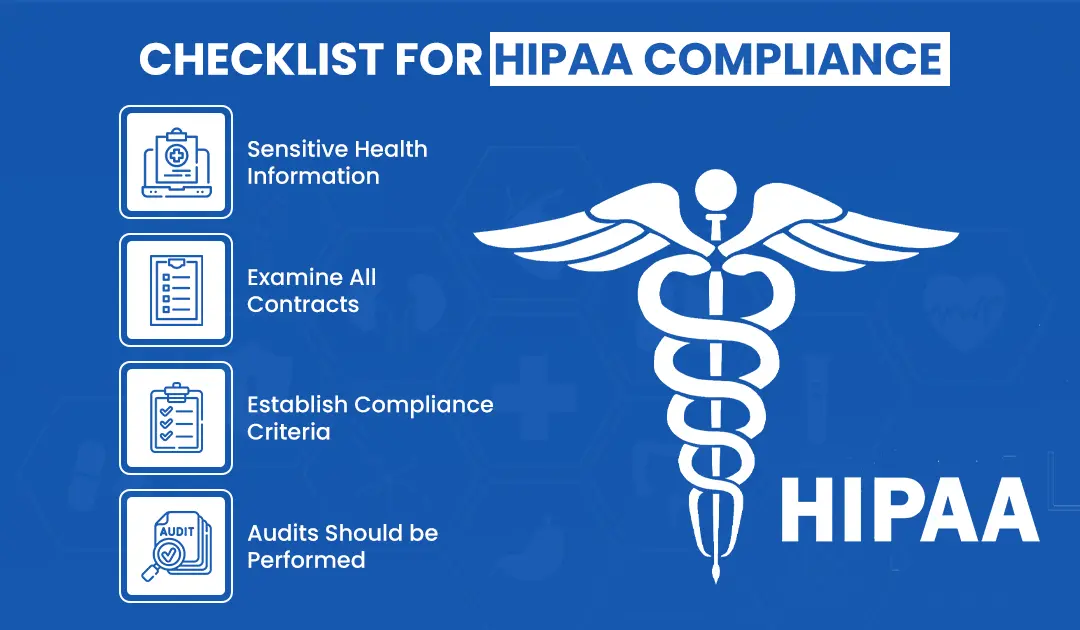
1. Locate all applications in your healthcare organization that contain sensitive health information
The first step in ensuring HIPAA compliance is to gather all health data locations and identify applications that store or transmit sensitive health information. When you are identifying the applications, you must consider not only the desktop and laptop computers, but also include any storage devices like file servers and portable drives.
You must establish a procedure to ensure that everyone who accesses this information must sign an agreement of confidentiality before he/she can access any data.
2. Examine all contracts
Examine all contracts and agreements that are related to health data, such as service agreements, employment or lease agreements including emails and other phone conversations.
3. Establish compliance criteria
Establish your compliance criteria and develop a formal HIPAA policy. All policies must be approved by your governing board before they are implemented.
4. Audits should be performed
All critical health data must be audited at least once every three months and all critical applications must be audited at least once a month.

What are the next Healthcare SaaS trends?
With the increasing global awareness of health issues, the healthcare industry has begun to use more technology to help cater to the growing needs of global users. The increased demand for efficient management of patient data and care delivery has led to high adoption rates of apps and software in the healthcare industry.
The reason to look at SaaS for Healthcare is that healthcare data is growing and the amount of data is constantly increasing. With this increase, it becomes very difficult to manage a lot of data and maintain a system. Also, the rapid change in workflow or specifications can disrupt normal processes.
SaaS provides a flexible solution for this problem and helps you fulfill your requirement with ease and convenience.
High-ranking hospitals have started using SaaS healthcare systems by using an on-premise solution or cloud as part of their strategy to improve efficiency, performance, and security.
Let’s talk about the upcoming trends in Healthcare SaaS:
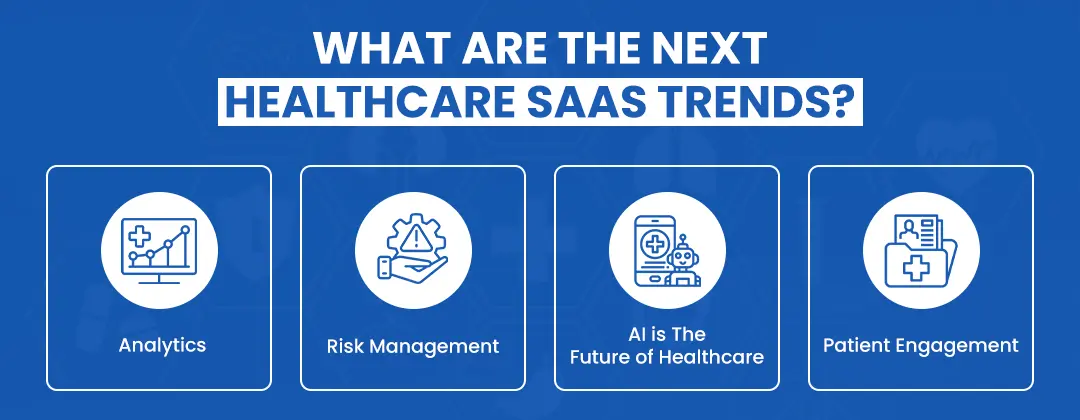
1. Analytics
The healthcare industry is turning towards analytics to gain insights and make better decisions for their processes and patient outcomes. The amount of healthcare data grows significantly every year. To analyze this data, you require high-performance analytics platforms.
2. Risk Management
Hospitals are using SaaS to manage risks like fraud and identity theft. With growing concerns over cyber attacks, it is becoming necessary for the healthcare industry to adopt new technologies which can protect the patients’ information from cyber threats.
SaaS applications are used for identity management because it makes it easier for healthcare organizations to access patient records at any time and ensure that only authorized people have access to them.
3. AI: Artificial intelligence is the future of healthcare
The healthcare industry is using artificial intelligence for risk management and improving the existing processes. This can be supported by the use of analytics, which in turn helps hospitals identify new solutions to make their processes better.
SaaS applications using artificial intelligence provide greater value to the organization in their industry and help them reduce costs and increase employee efficiency.
4. Patient Engagement
With the growing demand for seamless patient management, it becomes more and more important for patients to be engaged with their health care providers. The rise in mobile access and mobile device usage has also influenced patient engagement with healthcare providers.

How do you create a healthcare SaaS application?
Developing a healthcare SaaS application can be challenging in itself. If you want to create a healthcare SaaS application then we suggest you hire a healthcare software development company with an experienced team of expert healthcare software developers.
An experienced healthcare software development company can help you create a simple to complex healthcare application.
You need to focus on the value your healthcare SaaS app will bring to the customer and the vision for the overall application. It is important to keep your vision alive as you make decisions on a day-to-day basis.
Once you have a vision that you believe will create value for your customers and make them successful, it will help as a guide that can be used when making difficult decisions throughout the development process.

The underlying architecture of a healthcare SaaS application is an application stack comprising various components related to architecture level like frontend and backend, databases, caching & compute layers, etc.
What will be the process of healthcare SaaS application development?
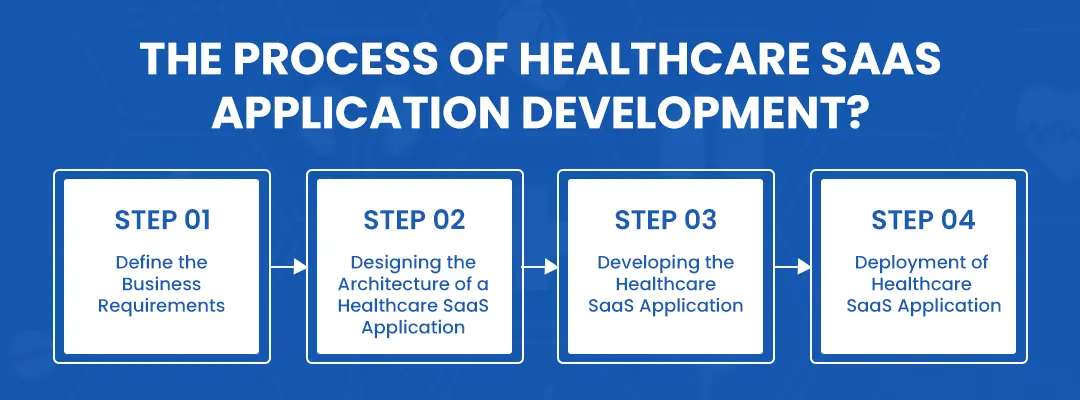
Step 1: Define the business requirements
Before you start development, you will need to clearly define your business requirements. If you are looking to develop a healthcare SaaS application then it’s important to work with an experienced healthcare software development company.
A company that has experience in developing and implementing Healthcare software applications can help you get your business requirement right before they begin the development of your SaaS app.
Step 2: Designing the architecture of a healthcare SaaS application
Once all the business requirements are defined, the next step is to design and develop the application architecture for your healthcare SaaS app. A healthcare SaaS application is an application that connects all the internal core functions of an organization via a centralized, web-based application.
The context in which you are developing your healthcare SaaS app will determine how you design and develop your architecture.
Your healthcare SaaS app is based on specific business processes which require specific types of data. These data types determine the way in which the app will be structured. For instance, medical data can only be stored on a database with a certain type of architecture, specifically a SQL database.
Step 3: Develop the healthcare SaaS application
Once you have designed and developed your healthcare SaaS app architecture, you can start developing your healthcare SaaS app. If you are not yet sure about where, to begin with, the development of your healthcare SaaS application, then it’s always great to get checked and get the right experts’ help. You can contact us for more details.
The best way to develop a healthcare SaaS application is using the help of a highly experienced team of experienced healthcare app developers who have knowledge in software development and implementation of various projects that requires highly complex applications.
Step 4: Deployment of healthcare SaaS application
You will have to deploy your healthcare SaaS application once it’s developed. A healthcare SaaS app will be used by a large number of people across the world. The infrastructure that’s required to maintain the level of availability and performance required by such an application is very different from a normal web application.
When you develop a healthcare SaaS app, you need calm and cool heads and someone who can go through all the processes with you in detail.

Summarizing
If you want to develop an effective healthcare SaaS app, you need to focus on different aspects which include user interface design, various features, and functionality, how your customer will interact with your app, end-to-end process flow design, and overall business requirements.
It’s always better to work with a healthcare software development company who have proven experience in developing other similar applications and can help you throughout the lifespan of your project.
If you are interested in how to develop a healthcare application using the right technology, you can connect with our experts to get in-depth information on developing a healthcare application using the right technology stack and customized solution development.
Hire healthcare software developers for your next project by getting in touch with our dedicated healthcare software developers to get your healthcare software developed.

Frequently Asked Questions
-
1. What is the difference between a healthcare SaaS application and a regular web application?
The overall goal of SaaS applications is to create a platform or a system that connects diverse systems and devices with each other. In this way, your healthcare applications can be used to support patient care and better serve the patient community. SaaS solutions provide solutions for the more complex needs of users. Additionally, it provides scalability and flexibility in addition to a faster development cycle.
-
2. How much does it cost to develop a healthcare SaaS application
The cost of developing a healthcare software application depends upon several factors like the type of solution you need, the complexity of your project, the requirement for customization, etc.
One of the most important factors that determine the cost of your healthcare SaaS application is whether you need an off-the-shelf software solution or a custom-made application. If you are looking for a custom-made healthcare SaaS app, then it will cost you more than an off-the-shelf solution.
Additionally, the cost of development depends on factors like location, programming language, and the experience of your developer team. Thus it is better to get in touch with our expert to understand all components.
-
3. Where can I get in detail information about how to develop a healthcare SaaS application?
In addition to our website, you can also get in detail information about how to develop a healthcare SaaS application by connecting with our experts. You can get detailed information on different steps that need to be taken to develop your healthcare SaaS app.
-
4. How long does it take to develop and implement a healthcare SaaS app?
The development of a healthcare SaaS application will depend on the target audience, business requirements, and technical expertise of your developer team. Thus it is best to check with your developer team as well as the business owner before you start the development process.

![The Complete Guide On SaaS for The Healthcare Industry [2022]](https://www.auxanoglobalservices.com/agsresources/wp-content/uploads/2022/05/The-Complete-Guide-On-SaaS-for-The-Healthcare-Industry-2022.webp)

